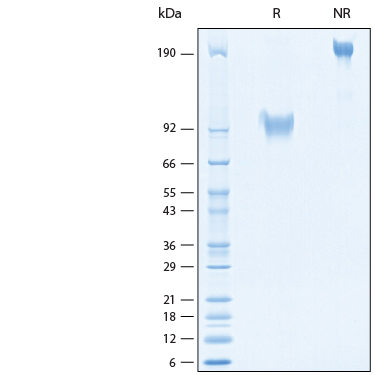Recombinant Cynomolgus IL-17RA/IL-17R Fc Chimera Protein, CF
Recombinant Cynomolgus IL-17RA/IL-17R Fc Chimera Protein, CF Summary
Product Specifications
| Cynomolgus Monkey IL-17RA (Leu33-Trp320) Accession # XP_005568119.1 | IEGRMD | Human IgG1 (Pro100-Lys330) |
| N-terminus | C-terminus | |
Analysis
Product Datasheets
Carrier Free
CF stands for Carrier Free (CF). We typically add Bovine Serum Albumin (BSA) as a carrier protein to our recombinant proteins. Adding a carrier protein enhances protein stability, increases shelf-life, and allows the recombinant protein to be stored at a more dilute concentration. The carrier free version does not contain BSA.
In general, we advise purchasing the recombinant protein with BSA for use in cell or tissue culture, or as an ELISA standard. In contrast, the carrier free protein is recommended for applications, in which the presence of BSA could interfere.
11235-IR
| Formulation | Lyophilized from a 0.2 μm filtered solution in PBS with Trehalose. |
| Reconstitution | Reconstitute at 250 μg/mL in PBS. |
| Shipping | The product is shipped at ambient temperature. Upon receipt, store it immediately at the temperature recommended below. |
| Stability & Storage: | Use a manual defrost freezer and avoid repeated freeze-thaw cycles.
|
Scientific Data
 View Larger
View Larger
Measured by its ability to inhibit IL-17-induced IL-6 secretion by NIH‑3T3 mouse embryonic fibroblast cells. The ED50 for this effect is 0.050‑0.500 µg/mL in the presence of 10.0 ng/mL Recombinant Human IL‑17A Protein (7955-IL).
 View Larger
View Larger
2 μg/lane of Recombinant Cynomolgus IL-17RA/IL-17R Fc Chimera Protein (Catalog # 11235-IR) was resolved with SDS-PAGE under reducing (R) and non-reducing (NR) conditions and visualized by Coomassie® Blue staining, showing bands at 93-103 kDa.
Reconstitution Calculator
Background: IL-17RA/IL-17R
IL-17 R, also known as IL-17 RA, is a 120 kDa type I transmembrane glycoprotein protein that plays a central role in inflammatory responses (1-3). Mature mouse IL‑17 R consists of a 291 amino acid (aa) extracellular domain, a 21 aa transmembrane segment, and a 521 aa cytoplasmic domain (4). The cytoplasmic domain contains a region homologous to the TIR domain of the TLR/IL-1 R family (5). Within the extracellular domain, cynomolgus monkey IL-17RA shares 95% sequence identity with human IL-17RA. While the expression of IL-17 is restricted to activated T cells, IL-17 R exhibits a broad tissue distribution (4). Even in the absence of ligand, IL-17 R exists on the cell surface as a multimer (6). IL-17 R can bind IL-17 but must associate with IL-17 RC to transduce signals (7, 8). Interestingly, human IL-17 R does not appear to form productive complexes with mouse IL-17 RC (8). The IL-17 R can also signal in response to IL-17F (9). IL-17 R ligation promotes T cell activation and the production of IL-6, G-CSF, SCF, and multiple pro‑inflammatory chemokines (4, 7, 9, 10). IL-17A and IL-17F synergize with TNF-alpha in the induction of CXCL1, G-CSF, and IL-6 (9, 11). This effect requires the presence of both TNF RI and TNF RII (9). IL-17 interactions with IL-17 R also inhibit the TNF-alpha induced up-regulation of fibroblast CCL5 and VCAM-1 (11). CCL5 and VCAM-1 induced effects are differentially sensitive to blockade with IL-17 R specific antibodies, suggesting that IL-17 R triggers divergent intracellular signals (11). In vivo, IL‑17 R activity is important for increased generation of neutrophils and their recruitment to sites of inflammation (10, 12, 13). IL-17 R is required for host defense against microbial infection and for the progression of arthritis from inflammation to destructive joint erosion (10, 13).
- Iwakura, Y. and H. Ishigame (2006) J. Clin. Invest. 116:1218.
- Moseley, T.A. et al. (2003) Cytokine Growth Factor Rev. 14:155.
- Kawaguchi, M. et al. (2004) J. Allergy Clin. Immunol. 114:1265.
- Yao, Z. et al. (1995) Immunity 3:811.
- Novatchkova, M. et al. (2003) Trends Biochem. Sci. 28:226.
- Kramer, J.M. et al. (2006) J. Immunol. 176:711.
- Hymowitz, S.G. et al. (2001) EMBO J. 20:5332.
- Toy, D. et al. (2006) J. Immunol. 177:36.
- McAllister, F. et al. (2005) J. Immunol. 175:404.
- Ye, P. et al. (2001) J. Exp. Med. 194:519.
- Schnyder, B. et al. (2005) Cytokine 31:191.
- Tan, W. et al. (2006) J. Immunol. 176:6186.
- Lubberts, E. et al. (2005) J. Immunol. 175:3360.
FAQs
No product specific FAQs exist for this product, however you may
View all Proteins and Enzyme FAQsReviews for Recombinant Cynomolgus IL-17RA/IL-17R Fc Chimera Protein, CF
There are currently no reviews for this product. Be the first to review Recombinant Cynomolgus IL-17RA/IL-17R Fc Chimera Protein, CF and earn rewards!
Have you used Recombinant Cynomolgus IL-17RA/IL-17R Fc Chimera Protein, CF?
Submit a review and receive an Amazon gift card.
$25/€18/£15/$25CAN/¥75 Yuan/¥1250 Yen for a review with an image
$10/€7/£6/$10 CAD/¥70 Yuan/¥1110 Yen for a review without an image



